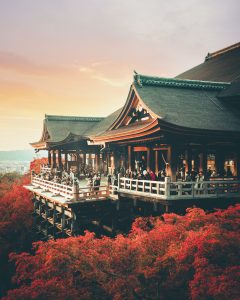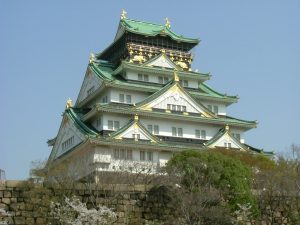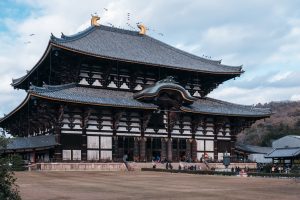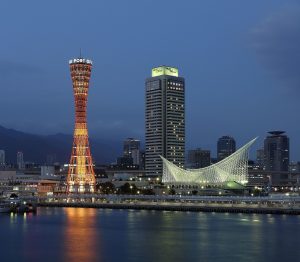Day 1 – Kyoto
 Kiyomizu-dera (清水寺, Kiyomizu Temple, “Pure Water Monastery”) is a Buddhist temple located in eastern Kyoto, Japan. The temple’s present buildings were constructed in 1633, ordered built by Tokugawa Iemitsu. There is not a single nail used in the entire structure. It takes its name from the waterfall within the complex, which runs off the nearby hills. Kiyomizu means clear water, or pure water.
Kiyomizu-dera (清水寺, Kiyomizu Temple, “Pure Water Monastery”) is a Buddhist temple located in eastern Kyoto, Japan. The temple’s present buildings were constructed in 1633, ordered built by Tokugawa Iemitsu. There is not a single nail used in the entire structure. It takes its name from the waterfall within the complex, which runs off the nearby hills. Kiyomizu means clear water, or pure water.
Sanjūsangen-dō is a Buddhist temple of the Tendai sect in the Higashiyama district of Kyoto, Japan. The temple was founded in 1164 by Taira no Kiyomori for the cloistered Emperor Go-Shirakawa. It is officially known as Rengeō-in and belongs to the Myōhō-in temple complex.
The Yasaka Shrine became the object of Imperial patronage during the early Heian period. Today, in addition to hosting the Gion Matsuri, Yasaka Shrine welcomes thousands of people every New Year, for traditional Japanese New Year rituals and celebrations. In April, the crowds pass through the temple on their way to Maruyama Park, a popular hanami (cherry blossom viewing) site. Lanterns decorate the stage with the names of festival sponsors.
Nishiki Market is a marketplace in downtown Kyoto, located on the east end of Nishikikōji Street, one block north and parallel to Shijō Street and west of Teramachi Street. Rich with history and tradition, the market is renowned as the place to obtain many of Kyoto’s famous foods and goods.
Fushimi Inari-taisha Shrine is famous for its tunnels of more than 10,000 closely-spaced orange torii gates that wind over the hills of Mt. Inari beyond the entrance to the shrine. Inari is the patron deity of agriculture and business, and Fushimi Inari Shrine is the number one Inari shrine in the whole of Japan.
Nijō Castle is a flatland castle in Kyoto, Japan. The castle consists of two concentric rings of fortifications, the Ninomaru Palace, the ruins of the Honmaru Palace, various support buildings and several gardens.
Day 2 – Kyoto
 Kinkaku-ji Temple is known as “the Golden Pavilion” for a very special reason – its top two stories are actually covered in gold leaf. Its shining surface reflects into the kyoko-chi, or Mirror Pondkyo.
Kinkaku-ji Temple is known as “the Golden Pavilion” for a very special reason – its top two stories are actually covered in gold leaf. Its shining surface reflects into the kyoko-chi, or Mirror Pondkyo.
The Arashiyama Bamboo Grove consists mostly of mōsō bamboo and has several pathways for tourists and visitors. The Ministry of the Environment considers it a part of the soundscape of Japan. Arashiyama is famous for its Sagano Romantic Train ride, whether during spring for its cherry blossoms or autumn for the brilliant colors of its maple leaves. It is also renowned for its landmark bridge, Togetsukyo which is used in many tourist promotion photos.
Tenryū-ji, formally known as Tenryū Shiseizen-ji, is the head temple of the Tenryū-ji branch of the Rinzai sect of Zen Buddhism. In 1994, Tenryuji became a UNESCO World Heritage Site. Tenryuji Temple in Kyoto is famous for the beauty of its autumn maple leaves.
Arashiyama Observation Deck is one of the famous spots to enjoy the view of Arashiyama. You can see beautiful greenery surrounding the town with a beautiful view of the mountain in the back.
Arashiyama Kimono Forest, some of the more than 30 traditional Kyo-Yuzen kimono fabric designs at the Arashiyama Kimono Forest. The Saga-Arashiyama area in the western part of Kyoto is one of the most popular tourist destinations in all of Japan.
Arashiyama Monkey Park Iwatayama is a commercial park located in Arashiyama in Kyoto, Japan. The park is on Mt Arashiyama, on the opposite side of the Ōi River as the train station. It is inhabited by a troop of over 120 Japanese macaque monkeys. The animals are wild but can be fed food purchased at the site.
Gion, Kyoto’s geisha district, is very atmospheric at night. If you want to learn more about geishas and their lifestyle take this guided night walk. If you really want to spoil yourself with a delicious traditional Japanese Kaiseki dinner, this Kyoto Night Food Tour is something for you.
Day 3 – Osaka
 Osaka Castle is a Japanese castle in Chūō-ku, Osaka, Japan. The castle is one of Japan’s most famous landmarks and it played a major role in the unification of No during the sixteenth century of the Azuchi-Momoyama period.
Osaka Castle is a Japanese castle in Chūō-ku, Osaka, Japan. The castle is one of Japan’s most famous landmarks and it played a major role in the unification of No during the sixteenth century of the Azuchi-Momoyama period.
Shitennoji temple is sometimes regarded as the first Buddhist and oldest officially-administered temple in Japan, although the temple complex and buildings have been rebuilt over the centuries, with the last reconstruction taking place in 1963. It is the head temple of the Wa Sect of Buddhism.
Sumiyoshi Taisha Shrine is the main shrine of all the Sumiyoshi shrines in Japan. However, the oldest shrine that enshrines the Sumiyoshi sanjin, the three Sumiyoshi kami, is the Sumiyoshi Shrine in Hakata.
teamLab Botanical Garden Osaka is an open-air botanical garden. The artworks in this exhibition transform interactively, influenced by wind and rain as well as the trees and birds that live in the garden. When the night falls, the garden grounds come alive with the immersive installations of teamLab’s permanent exhibition, turning into a surreal world of color and light.
Kuromon Market, Spacious market with vendors selling street food, fresh produce & shellfish, plus souvenirs.
Dōtonbori or Dōtombori is one of the principal tourist destinations in Osaka, Japan, running along the Dōtonbori canal from Dōtonboribashi Bridge to Nipponbashi Bridge in the Namba district of the city’s Chuo ward.
Day 4 – Nara (Option A)
 Todai-ji Nigatsu-dō is one of the important structures of Tōdai-ji, a temple in Nara, Japan. Nigatsu-dō is located to the east of the Great Buddha Hall, on the hillside of Mount Wakakusa. It includes several other buildings in addition to the specific hall named Nigatsu-dō, thus comprising its own sub-complex within Tōdai-ji.
Todai-ji Nigatsu-dō is one of the important structures of Tōdai-ji, a temple in Nara, Japan. Nigatsu-dō is located to the east of the Great Buddha Hall, on the hillside of Mount Wakakusa. It includes several other buildings in addition to the specific hall named Nigatsu-dō, thus comprising its own sub-complex within Tōdai-ji.
Kōfuku-ji is a Buddhist temple that was once one of the powerful Seven Great Temples in the city of Nara, Japan. The temple is the national headquarters of the Hossō school.
Alongside Naramachi and Nishinokyo, Nara Park is one of the must-see areas in Nara City. The vast area covers 660 hectares and is renowned for its free-roaming deer and world famous temples. Feeding the deer is an attraction in itself and special crackers are on sale all around the park.
Sanjo dori Street is a boulevard running through the heart of Nara City, the prefectural seat of government, in the east-west direction. Summary. Starting at the torii gate of Kasuga-taisha Shrine, the road extends into Ikoma City (Nara Prefecture) and to Kuragari-toge Pass in Mt. Ikoma.
Isuien Garden and Neiraku Museum opened in April 1969. It contains the works collected by Nakamura Junsaku (1875–1953), who was the founder of the Isuien Garden. The collection totals over 2000 items, which includes bronze wares, seals and mirrors of ancient China as well as pottery of ancient Korea. The museum building was built in a traditional style and features rotating exhibitions.
Day 4 – Kobe (Option B)
 Nunobiki Falls is a set of waterfalls near downtown Kobe, Japan, with an important significance in Japanese literature and Japanese art. In Japan, Nunobiki is considered one of the greatest “divine falls” together with Kegon Falls and Nachi Falls.
Nunobiki Falls is a set of waterfalls near downtown Kobe, Japan, with an important significance in Japanese literature and Japanese art. In Japan, Nunobiki is considered one of the greatest “divine falls” together with Kegon Falls and Nachi Falls.
Ikuta Shrine (生田神社, Ikuta-jinja) is a Shinto shrine in the Chūō Ward of Kobe, Japan, and is possibly among the oldest shrines in the country.
There remains the historic landmark “Ikuta Forest ” in the northern part of the silent precinct of the shrine, which is well known as the battle field of Genpei War.
Kobe Chinatown Nankin-machi is a neighborhood in Kobe, Japan located south of Motomachi station adjacent to the Daimaru Department Store and is a major tourist attraction. Considered as Kobe’s Chinatown, the area has over a hundred Chinese restaurants, shops, and a Chinese temple dedicated to Lord Guan.
Mount Rokko Cable Car opened in 1932. The cable car connects the Rokko Cable Lower Station at the foot of the mountain, which has a height difference of approximately 500 m and a total length of approximately 1,700 m, to the Rokko Sanjo Station in approximately 10 minutes.
Weathercock House (The Former Thomas House) By all means, feel the history and sightseeing scenery of Kobe, and drop in at Kobe’s Ijinkan, Kazamidori no Yakata.